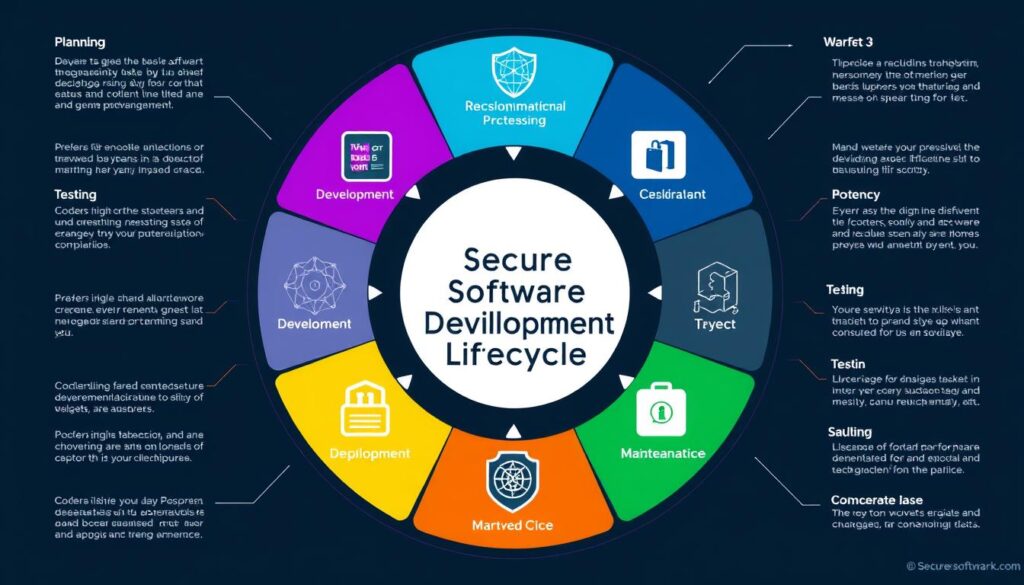Today, the rise in cyber threats highlights the need for secure software development. Recent breaches, like the SolarWinds attack, show why strong cybersecurity is crucial. These incidents underline the need to focus on software vulnerabilities and build a security culture throughout the development lifecycle.
It’s time to see secure coding as a key part of innovation, not a barrier. Companies, from startups to big corporations, should update their security plans. They can follow the NIST Secure Software Development Framework (SSDF) to protect against today’s cyber threats.
Key Takeaways
- Heightened cyber risks mandate the integration of secure software development practices and policies.
- Regulatory bodies scrutinize the adoption of security measures throughout the software development lifecycle.
- Early and continuous security testing is key to uncovering and mitigating software vulnerabilities before deployment.
- A comprehensive grasp of secure coding techniques is critical for the development of resilient software systems.
- Frameworks like the NIST Secure Software Development Framework guide organizations in best practices for cybersecurity.
- Developers must prioritize secure coding to combat the complex cybersecurity landscape of today.
Understanding Secure Software Development Practices
In our digital age, making sure software is safe from the start is crucial. DevSecOps makes security part of the whole software making process. Starting security measures early helps prevent future problems, making software safer from hacks.

Definition of Secure Software Development
Secure software development means adding safety steps at every stage, from the first design to the final release. This method makes software that works well and is safe from threats. Using guidelines like the Secure Software Development Framework (SSDF) by NIST ensures security is a core part of making software.
Importance in Today’s Digital Landscape
Today’s digital world is full of security risks that threaten data and can upset business. Having security steps in software making is key to protecting data and keeping customers’ trust. Facing smarter cyber threats, strong security in software making stops big losses of money and reputation.
Key Principles to Follow
To make software safely, certain important steps must be followed:
- Proactive Risk Management: Deal with risks early to avoid future breaches.
- Continuous Integration and Deployment: Updates and fixes, as noted in DevSecOps practices, keep software safe.
- Regular Code Reviews: Checking code carefully finds weak spots that hackers could use.
- Adherence to Standards: Using established rules and guidelines makes security reliable.
Putting these steps into the software making process boosts security against cyber threats.
Ignoring security in software development has big risks today. It can lead to huge monetary losses, loss of trust, and damage to your brand. Adding strong security measures during development is essential, not just optional.
Incorporating Security in the Development Lifecycle
Software development has changed a lot. Now, it’s crucial to include secure coding standards, continuous integration, and risk management. These steps are key not just for data protection. They also maintain technology trust. By adding security from the start, companies can lower risks. This makes their software more reliable.
Security-Focused Planning and Requirements
Security must be a top priority from the start. This means setting strong security goals that meet business and standard needs. Applying the NIST Secure Software Development Framework (SSDF) helps. With it, every development step adds to the app’s security. For 60 years, the idea of embedding security throughout the development cycle was not given much focus. Starting with security early is essential.
Continuous Security Testing and Integration
Using automated tools for security testing is smart. Tools like static analysis help find and fix weak spots fast. With continuous integration, security checks happen all the time. This approach cuts down the risk of attacks and lowers fix costs. It’s much better than old methods, which could delay updates for weeks.
Threat Modeling Techniques
Threat modeling looks at possible threats and plans how to stop them. It’s a proactive step to find and fix security gaps early. This method is crucial for managing risks. Knowing the threats helps developers make stronger apps. These apps are better at stopping cyber-attacks.

The main idea is to make security a core part of creating software. By following secure coding rules and keeping up with security, plus risk management, companies protect their apps. This defense is vital against increasing cyber threats.
Popular Frameworks and Methodologies
In the fast-changing world of tech, using secure software development frameworks and methods is key. Agile methodologies are important because they help adapt quickly and respond early to security threats. Plus, following OWASP guidelines helps organizations tackle security weaknesses better.
Agile Security Practices
Adding security into Agile methods marks a big step towards stronger software development. Unlike the old Waterfall model, Agile lets you continuously add and check security at every step. This makes the development safer and more efficient against new threats.
DevSecOps: Merging Development, Security, and Operations
DevSecOps takes Agile ideas further by making security a core part of the development from the start. This means less security risks, as every development phase includes security. Tools like Spring Boot for Java and Django for Python help mix security right into the coding process.
OWASP Top Ten and Its Relevance
The OWASP Top Ten lists major web security risks. It’s vital for developers who want to follow the best security practices. It also offers a way to regularly check and boost software safety.
| Framework/Methodology | Developed | Key Benefit |
|---|---|---|
| Waterfall Model | 1970 | Linear progression, good for simple, unchanging projects |
| Agile | Ongoing evolution | Flexibility, efficiency in handling new threats |
| BSA Framework | 2019 | Risk-based, security-focused |
| NIST SSDF | 2021 | Reduces security vulnerabilities |
| React Native | Recent adoption | Facilitates mobile development with integrated security |
| Spiral Model | Uses in large projects | Integrates risk management effectively |
By using Agile methods and OWASP rules in frameworks like NIST’s SSDF, companies can be proactive in software development. This strategy helps keep security up-to-date with both digital threats and fast tech advances.
Training and Awareness for Development Teams
It’s key to give development teams secure software development training. This boosts cybersecurity awareness in a company. Teams get special training that fits their role. This helps developers, testers, and security champions learn about application security and privacy.
Such training introduces standard security practices. It also encourages a security-first mindset. This mindset is needed for making innovative software safely.
Security Training for Developers
Good training programs start with a plan. All the people making software learn about security in detail. They go through training that focuses on important parts of making software. This includes learning how to spot and defend against security threats.
Through interactive sessions, developers and security experts learn secure coding. This reduces the chance of security issues.
Building a Security-Centric Culture
Creating a culture that puts security first is about ongoing training. Teams learn to think like hackers to better defend against attacks. They use games and talks to understand security better. This keeps the training interesting and useful.
Security Champions play a big role here. They get extra training and then teach their teams. This helps spread good security practices.
Resources for Ongoing Education
To keep improving, organizations use systems to track training and certifications. Keeping up with new security updates and getting regular certifications is vital. Teams need to always know the latest in security. This helps everyone stay sharp on security matters.
There are clear rules for training, like getting certified when you start and refreshing your knowledge every 24 months. This keeps the team’s security knowledge strong. It makes the company’s defenses better too.
Bringing secure software development training, cybersecurity awareness, and a security-first mindset together is key. It makes software systems much safer. This training makes sure security is built into the software from the start. It fits with the company’s security aims.
Measuring and Improving Security Posture
Today’s digital world changes fast, making strong security more important than ever. A recent report shows cyber attacks increased by 7% globally in early 2023. This proves we need good security measures.
Security metrics are vital for checking how well an organization can handle threats. On average, each organization faces 1,248 attacks every week. Also, 70% of cybersecurity experts find tracking vulnerabilities hard. By understanding these issues, companies can improve their security strategies.
Key Metrics for Secure Software Development
Choosing the right security metrics is crucial for defense. These metrics help understand the effectiveness of security practices. They also show how well an organization can deal with cyber threats.
Managing security posture is getting tougher, as 36% of professionals say. The challenge is partly due to an increasing attack surface. AppSec teams need to work closely with development groups. This is to ensure digital assets are safe, as 90% agree on the need for better teamwork.
Conducting Post-Deployment Security Reviews
Post-deployment reviews are key steps in the software development cycle. They help ensure security standards are met. These reviews also teach teams how to avoid future vulnerabilities.
76% of organizations have faced cyber attacks through unmanaged web-based assets. The average data breach costs $3.33 million. So, post-deployment reviews are not only necessary for security but also for financial reasons.
Adapting to Emerging Threats and Technologies
Being adaptable in cybersecurity means more than using new tools. It means understanding and predicting future cyber threats. Staying ahead of threats like ransomware and DDOS attacks is essential.
Frameworks like NIST’s SSDF and Google’s SLSA are key for maintaining software integrity. With 71% of AppSec teams feeling overwhelmed, staying alert with AI’s help is crucial. This helps protect an organization’s most important assets.
FAQ
What are secure software development practices?
Secure software development practices aim to make software safe. These practices involve security from the start of making software until it is complete. They help protect against online risks and follow cybersecurity rules.
Why are secure coding techniques important?
Secure coding techniques are critical. They stop common software problems that hackers can use. Using these methods, developers can lower the chances of data theft. This protects both the company and its customers.
What encompasses the secure software development lifecycle?
The secure software development lifecycle includes security from planning to maintenance. Including security early on helps manage risks better. This improves the safety of software products over their entire life.
What is the role of DevSecOps in secure software development?
DevSecOps mixes security into the DevOps process. It ensures security steps are part of all development stages. The goal is to quickly and safely make, test, and release software.
How does continuous integration contribute to security?
Continuous integration involves regularly combining code changes. It allows for quick automated tests. This helps find and fix security issues fast, improving software security.
Why is risk management essential in secure software development?
Risk management identifies and deals with potential software risks. It assesses threats and uses security steps. This approach is key to keeping software safe throughout its development.
How do Agile security practices improve software development?
Agile security practices include security in each step of development. They use quick, secure updates to respond to threats early. This makes software more secure as it’s developed.
What is the significance of the OWASP Top Ten in development?
The OWASP Top Ten lists top web security risks. It helps developers understand and prevent common web threats. This guide is essential for making safer web applications.
How can companies foster a security-centric culture among their development teams?
Companies encourage a focus on security by training developers on safe coding and cybersecurity. They also emphasize security in all project stages. This builds a team alert to security.
What kind of security metrics are useful for secure software development?
Useful metrics include tracking vulnerabilities and how fast they’re fixed. Also, checking the frequency of security checks and user issues. These metrics help improve security over time.
How should organizations adapt to emerging threats and technologies?
Organizations adapt by staying up-to-date with threats and security practices. They should regularly update software and evaluate risks with new tech. Keeping security skills sharp is also crucial.



